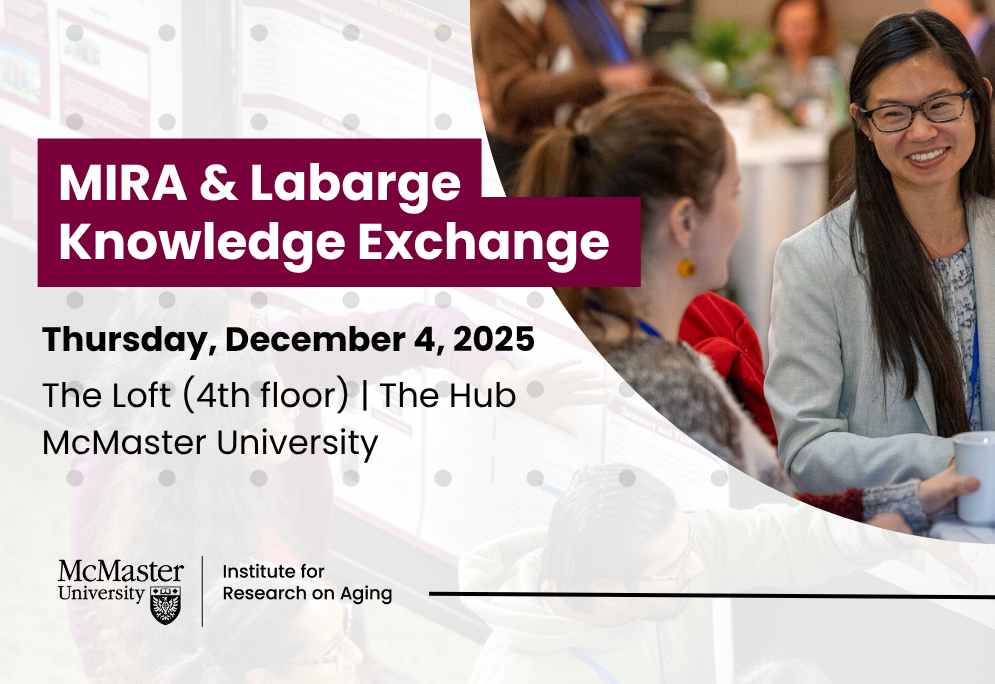
Published: January 17, 2020 | By Emily Dunford
Dr. Nora Bakaa, BSc, DC, is an MSc student in the School of Rehabilitation Sciences under the supervision of Dr. Luciana Macedo. During this interview, Nora spoke to us about her ongoing research and involvement with the MIRA Trainee Network.
Q: Tell us about the research project you are currently working on.
My research focus is on understanding exercise adherence behaviours in patients’ post-total knee arthroplasty. First, we will conduct a longitudinal cohort study to help us understand the factors that predict exercise adherence in this population. Then, we will conduct qualitative interviews on patients post-surgery to help us better understand the personal and environmental factors that may impact recovery and exercise behaviour.
Q: How does it relate to the aging population?
Osteoarthritis (OA) is considered one of the leading causes of disability worldwide. Knee OA is the most common form of OA, and when conservative management fails, total knee arthroplasty (TKA) is often recommended. In Canada, there are over 70,000 TKA’s performed annually. While some individuals post-TKA report significantly decreased pain, increased mobility, and function, others continue to have a long-term disability and reduced health-related quality of life. Regular exercise has been shown to improve individual health outcomes post-surgery, however, over 50% of older adults do not adhere to exercise recommendations post-surgery.
Q: What is the ultimate goal/purpose of this research?
Identifying and understanding the factors that may impede or facilitate exercise adherence immediately post-op may provide insight into improving patient outcomes through the development of targeted interventions in this population.
Q: At this point in your research, what do you think are the main barriers to older adults adhering to exercise post-surgery?
I think some of the main barriers to exercise adherence post-surgery include:
1) Access to proper post-operative rehabilitation,
2) Lack of social support
3) Inability to self-regulate
3) Pain during exercise
4) Attitudes towards exercise (e.g. fear-avoidance behaviours)
Q: Do you have a personal connection that makes you passionate about this research?
I’ve always been very passionate about research, and as a practicing chiropractor, I am a strong advocate for evidence-based medicine. Having worked with many patients suffering from musculoskeletal pain, I have seen first-hand the importance of continued research in this field. With my clinical experience and background in psychology, I wanted to approach pain management through a biopsychosocial lens. Since lack of exercise adherence is such a large aspect of clinical practice, I wanted to combine my academic and clinical interests to focus on getting patients to play a more active role in their recovery.
Q: How does this research fit into your chiropractic training and practice?
The role of a chiropractor encompasses several aspects such as engaging in research and innovation, being a leading advocate for the musculoskeletal health of all Canadians and most importantly fostering strong relationships with patients. Strong relationships are formed through our patient care via manual therapy and rehabilitation. Though often overlooked, exercise is a significant factor in pain management. Most studies have shown that regular exercise and physical activity activates anti-inflammatory pathways that help to reduce pain. One of the main challenges I encounter clinically is getting patients to want to complete their exercises daily. Most patients agree that exercise will help them feel better in the long term, but still don’t adhere despite knowing its importance. My research focuses on exercise adherence to post-operative total knee arthroplasty. Most patients with severe knee osteoarthritis cite pain as a limitation for lack of exercise, however, there is often little to no improvement in exercise and physical activity post-surgery despite improvements in pain and function. The results of this research help clinicians to better understand the barriers to exercise adherence and how to help implement targeted patient-specific rehabilitation.
Q: What are some of the creative ways that patients can incorporate movement and exercise when they are post-knee surgery?
Exercise is likely the single most important thing in maintaining health and quality of life, particularly in older adults. Post-operatively (or even generally in older adults), there are many ways to incorporate exercise in daily activities, for example:
• Walking around the mall or to the park can improve cardiovascular endurance and improve the range of motion of the knee.
• Squatting while watching TV to improve muscle strength in the lower limbs.
• Biking, swimming, dance or yoga are excellent, low-impact, activities that can improve cardiovascular function and endurance, as well as balance and flexibility.
• Bowling is both a social and physical activity that can increase muscle strength and cardiovascular endurance.
Post-operatively, patients should check in with a healthcare professional to make sure they are progressing their exercise/physical activity level safely. The most important thing is to remember that motion is the best medicine. According to the most recent physical activity guidelines, older adults should try to incorporate 1 hour of moderate-intensity exercise into their daily routine.
This ​blog post was first published by the MIRA Trainee Network. Read the ​original article.​​

